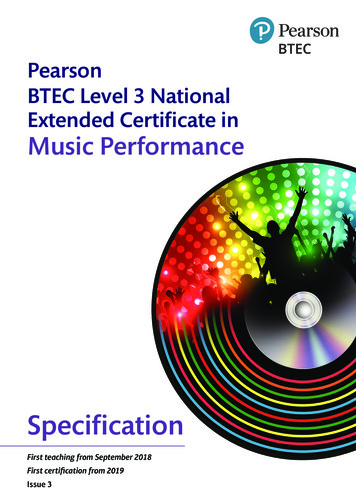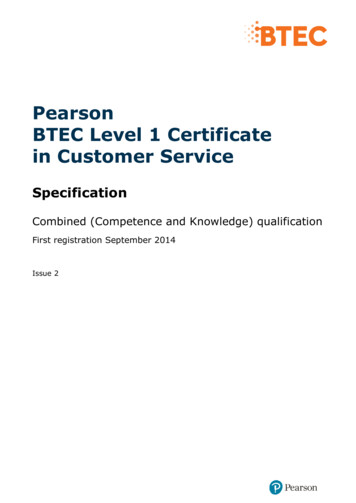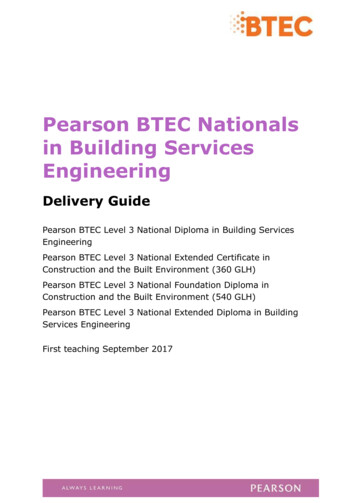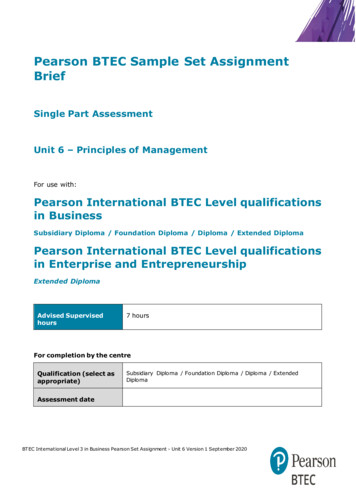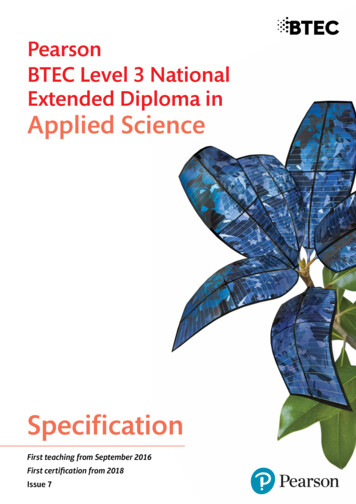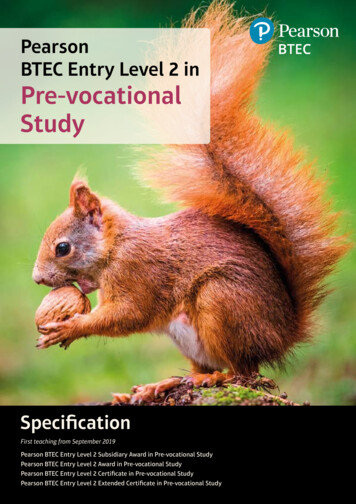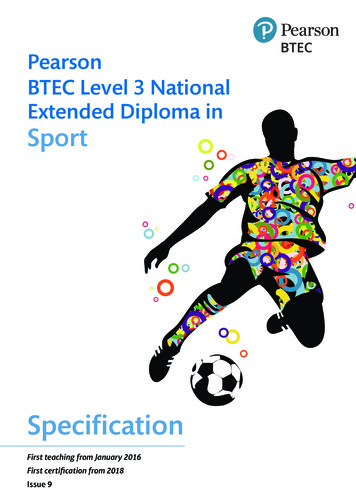
Transcription
PearsonBTEC Level 3 NationalExtended Diploma inSportSpecificationFirst teaching from January 2016First certification from 2018Issue 9
PearsonBTEC Level 3 NationalExtended Diplomain SportSpecificationFirst teaching September 2016Issue 9
Edexcel, BTEC and LCCI qualificationsEdexcel, BTEC and LCCI qualifications are awarded by Pearson, the UK’s largest awarding bodyoffering academic and vocational qualifications that are globally recognised and benchmarked.For further information, please visit our qualifications website at qualifications.pearson.com.Alternatively, you can get in touch with us using the details on our contact us page atqualifications.pearson.com/contactusAbout PearsonPearson is the world's leading learning company, with 25,000 employees in more than 70 countriesworking to help people of all ages to make measurable progress in their lives through learning.We put the learner at the centre of everything we do, because wherever learning flourishes, so dopeople. Find out more about how we can help you and your learners at qualifications.pearson.comThis specification is Issue 9. We will inform centres of any changes to this issue. The latest issuecan be found on our website.References to third-party material made in this specification are made in good faith. We do notendorse, approve or accept responsibility for the content of materials, which may be subject tochange, or any opinions expressed therein. (Material may include textbooks, journals, magazinesand other publications and websites.)ISBN 978 1 446 95827 8All the material in this publication is copyright Pearson Education Limited 2021
WelcomeWith a track record built over 30 years of learner success, BTEC Nationals are widely recognisedby industry and higher education as the signature vocational qualification at Level 3. They provideprogression to the workplace either directly or via study at a higher level. Proof comes fromYouGov research, which shows that 62% of large companies have recruited employees with BTECqualifications. What’s more, well over 100,000 BTEC students apply to UK universities every yearand their BTEC Nationals are accepted by over 150 UK universities and higher education institutesfor relevant degree programmes either on their own or in combination with A Levels.Why are BTECs so successful?BTECs embody a fundamentally learner-centred approach to the curriculum, with a flexible,unit-based structure and knowledge applied in project-based assessments. They focus on theholistic development of the practical, interpersonal and thinking skills required to be able tosucceed in employment and higher education.When creating the BTEC Nationals in this suite, we worked with many employers, higher educationproviders, colleges and schools to ensure that their needs are met. Employers are looking forrecruits with a thorough grounding in the latest industry requirements and work-ready skills suchas teamwork. Higher education needs students who have experience of research, extended writingand meeting deadlines.We have addressed these requirements with: a range of BTEC sizes, each with a clear purpose, so there is something to suit eachlearner’s choice of study programme and progression plans refreshed content that is closely aligned with employers’ and higher education needs for askilled future workforce assessments and projects chosen to help learners progress to the next stage. This meanssome are set by you to meet local needs, while others are set and marked by Pearsonso that there is a core of skills and understanding that is common to all learners. Forexample, a written test can be used to check that learners are confident in using technicalknowledge to carry out a certain job.We are providing a wealth of support, both resources and people, to ensure that learners and theirteachers have the best possible experience during their course. See Section 10 for details of thesupport we offer.A word to learnersToday’s BTEC Nationals are demanding, as you would expect of the most respected applied learningqualification in the UK. You will have to choose and complete a range of units, be organised, takesome assessments that we will set and mark, and keep a portfolio of your assignments. But youcan feel proud to achieve a BTEC because, whatever your plans in life – whether you decide tostudy further, go on to work or an apprenticeship, or set up your own business – your BTECNational will be your passport to success in the next stage of your life.Good luck, and we hope you enjoy your course.
Collaborative developmentStudents completing their BTEC Nationals in Sport will be aiming to go on to employment,often via the stepping stone of higher education. It was, therefore, essential that we developedthese qualifications in close collaboration with experts from professional bodies, businesses anduniversities, and with the providers who will be delivering the qualifications. To ensure that thecontent meets providers’ needs and provides high-quality preparation for progression, we engagedexperts. We are very grateful to all the university and further education lecturers, teachers,employers, professional body representatives and other individuals who have generously sharedtheir time and expertise to help us develop these new qualifications.In addition, universities, professional bodies and businesses have provided letters of supportconfirming that these qualifications meet their entry requirements. These letters can be viewed onour website.
Summary of Pearson BTEC Level 3 National Extended Diplomain Sport specification Issue 9 changesSummary of changes made between the previous issue andthis current issuePage numberThe last paragraph of the Qualification and unit content section has beenamended to allow centres delivering the qualification above to alter thecontent to reflect the context of the country where it is being delivered.Page 7Addition of progression routes to BTEC Higher Nationals.Page 11If you need further information on these changes or what they mean, contact us via our website s.html.
ContentsIntroduction to BTEC National qualifications for the sport sector1Total Qualification Time2Qualifications, sizes and purposes at a glance3Structures of the qualifications at a glance5Qualification and unit content7Assessment7Grading for units and qualifications9UCAS Tariff points91 Qualification purpose102 Structure123 Units16Understanding your units16Index of units194 Planning your programme2835 Assessment structure and external assessment297Introduction297Internal assessment297External assessment2976 Internal assessment299Principles of internal assessment299Setting effective assignments301Making valid assessment decisions303Planning and record keeping3057 Administrative arrangements306Introduction306Learner registration and entry306Access to assessment306Administrative arrangements for internal assessment307Administrative arrangements for external assessment308Dealing with malpractice in assessment310Certification and results312Additional documents to support centre administration3128 Quality assurance3139 Understanding the qualification grade31410 Resources and support319Support for setting up your course and preparing to teach319Support for teaching and learning320Support for assessment320Training and support from Pearson321Appendix 1 Links to industry standards323Appendix 2 Glossary of terms used for internally-assessed units324
Introduction to BTEC National qualificationsfor the sport sectorThis specification contains the information you need to deliver the Pearson BTEC Level 3 NationalExtended Diploma in Sport. The specification signposts you to additional handbooks and policies.It includes all the units for this qualification.This qualification is part of the suite of Sport qualifications offered by Pearson. In the suite thereare qualifications that focus on different progression routes, allowing learners to choose the onebest suited to their aspirations.All qualifications in the suite share some common units and assessments, allowing learners someflexibility in moving between sizes. The qualification titles are given below.Some BTEC National qualifications provide a broad introduction that gives learners transferableknowledge and skills. These qualifications are for post-16 learners who want to continue theireducation through applied learning. The qualifications prepare learners for a range of highereducation courses and job roles related to a particular sector. They provide progression either bymeeting entry requirements in their own right or by being accepted alongside other qualificationsat the same level and adding value to them.In the sport sector these qualifications are:Pearson BTEC Level 3 National Certificate in Sport (603/0458/3)Pearson BTEC Level 3 National Extended Certificate in Sport (601/7218/6)Pearson BTEC Level 3 National Foundation Diploma in Sport (601/7220/4)Pearson BTEC Level 3 National Diploma in Sport (603/0460/1)Pearson BTEC Level 3 National Extended Diploma Sport (603/0459/5).Some BTEC National qualifications are for post-16 learners wishing to specialise in a specificindustry, occupation or occupational group. The qualifications give learners specialist knowledgeand skills, enabling entry to an Apprenticeship or other employment, or progression to relatedhigher education courses. Learners taking these qualifications must have a significant level ofemployer involvement in their programmes.In the sport sector the qualification is:Pearson BTEC Level 3 National Diploma in Fitness Services (720 GLH) (601/7215/0).This specification signposts all the other essential documents and support that you need as acentre in order to deliver, assess and administer the qualification, including the staff developmentrequired. A summary of all essential documents is given in Section 7. Information on how we cansupport you with this qualification is given in Section 10.The information in this specification is correct at the time of publication.Pearson BTEC Level 3 National Extended Diploma in SportSpecification – Issue 9 – April 2021 Pearson Education Limited 20211
Total Qualification TimeFor all regulated qualifications, Pearson specifies a total number of hours that it is estimatedlearners will require to complete and show achievement for the qualification: this is the TotalQualification Time (TQT). Within TQT, Pearson identifies the number of Guided Learning Hours(GLH) that we estimate a centre delivering the qualification might provide. Guided learning meansactivities, such as lessons, tutorials, online instruction, supervised study and giving feedback onperformance, that directly involve teachers and assessors in teaching, supervising and invigilatinglearners. Guided learning includes the time required for learners to complete external assessmentunder examination or supervised conditions.In addition to guided learning, other required learning directed by teachers or assessors will includeprivate study, preparation for assessment and undertaking assessment when not undersupervision, such as preparatory reading, revision and independent research.BTEC Nationals have been designed around the number of hours of guided learning expected. Eachunit in the qualification has a GLH value of 60, 90 or 120. There is then a total GLH value for thequalification.Each qualification has a TQT value. This may vary within sectors and across the suite depending onthe nature of the units in each qualification and the expected time for other required learning.The following table shows all the qualifications in this sector and their GLH and TQT values.2Pearson BTEC Level 3 National Extended Diploma in SportSpecification – Issue 9 – April 2021 Pearson Education Limited 2021
Qualifications, sizes and purposes at a glanceTitleSize and structureSummary purposePearson BTEC Level 3National Certificate inSport180 GLH (240 TQT)An introduction to the sport sectorthrough applied learning that supportsprogression to higher education.Pearson BTEC Level 3National ExtendedCertificate in SportEquivalent in size to 0.5of an A Level.2 units, both mandatory,of which 1 is external.Mandatory content (100%).External assessment (66%).It forms part of a programme of studythat includes other vocational or generalqualifications.360 GLH (445 TQT)A broad basis of study for the sportsector.Equivalent in size to oneA Level.4 units of which 3 aremandatory and 2 areexternal.Mandatory content (83%).External assessment (67%).Pearson BTEC Level 3National FoundationDiploma in Sport540 GLH (695 TQT)Equivalent in size to 1.5A Levels.7 units of which 4 aremandatory and 2 areexternal.Mandatory content (67%).External assessment (44%).Pearson BTEC Level 3National Diploma inSport720 GLH (895 TQT)Equivalent in size to twoA Levels.9 units of which 6 aremandatory and 3 areexternal.Mandatory content (75%).External assessment (45%).Pearson BTEC Level 3National ExtendedDiploma in Sport1080 GLH (1390 TQT)Equivalent in size to threeA Levels.14 units of which 10 aremandatory and 4 areexternal.Mandatory content (78%).External assessment (42%).Pearson BTEC Level 3 National Extended Diploma in SportSpecification – Issue 9 – April 2021 Pearson Education Limited 2021This qualification is designed to supportprogression to higher education whentaken as part of a programme of studythat includes other appropriate BTECNationals or A Levels.This qualification is designed as aone-year, full-time course covering theunderpinning knowledge for the sportsector and supporting progression to anapprenticeship in the sport sector or toa further year of study at Level 3.It supports progression to highereducation if taken as part of aprogramme of study that includes otherBTEC Nationals or A/AS Levels.This is intended as an Applied Generalqualification, equivalent in size to twoA Levels. It has been designed as partof a two-year programme, normally inconjunction with one or morequalifications at Level 3. Thisqualification is aimed at learners lookingto progress to higher education in thissector.This is intended as an Applied Generalqualification, equivalent in size to threeA Levels. It is a two-year, full-timecourse that meets entry requirements inits own right for learners who want toprogress to higher education courses insport before entering employment.3
TitleSize and structureSummary purposePearson BTEC Level 3National Diploma inFitness Services720 GLH (910 TQT)This is intended as a Tech Levelqualification, equivalent in size to twoA Levels. It has been designed as partof a two-year programme, normally inconjunction with one or morequalifications at Level 3. Thisqualification is aimed at learners lookingto progress to employment in thissector. This qualification is mapped toindustry standards for the fitnessindustry. It is designed for entry to rolessuch as gym instructor or fitnessinstructor, and is appropriate forprogression to Level 3 Personal Trainerqualifications or degree programmes.Equivalent in size to twoA Levels.10 units of which 7 aremandatory and 2 areexternal.Mandatory content (75%).External assessment (33%).4Pearson BTEC Level 3 National Extended Diploma in SportSpecification – Issue 9 – April 2021 Pearson Education Limited 2021
Structures of the qualifications at a glanceThis table shows all the units and the qualifications to which they contribute. The full structure for this Pearson BTEC Level 3 National in Sport is shown inSection 2. You must refer to the full structure to select units and plan your programme.KeyUnit assessed externallyFSMMandatory unitsOOptional unitsFitness ServicesUnit (number and tionDiplomaDiplomaDiplomaExtendedDiploma(GLH)(180 GLH)(360 GLH)(540 GLH)(720 GLH)(720 GLH)(1080 GLH)FS1Anatomy and Physiology1202Fitness Training and Programming forHealth, Sport and Well-being3MMMMMM120MMMMMProfessional Development in the SportsIndustry60MMMMM4Sports Leadership60OMOMM5Application of Fitness Testing60OOMOO6Sports Psychology60OOOO7Practical Sports Performance60OOOM8Coaching for Performance60OOM9Research Methods in Sport60OOM10 Sports Event Organisation60OOO11 Research Project in Sport60OOO12 Self-employment in the Sports Industry60M13 Instructing Gym-based Exercise60M14 Exercise and Circuit-based PhysicalActivity60M15 Instructing Exercise to Music60O16 Instructing Water-based Exercise60O17 Sports Injury Management60OOO18 Work Experience in Active Leisure60OOOMPearson BTEC Level 3 National Extended Diploma in SportSpecification – Issue 9 – April 2021 Pearson Education Limited 20215
Unit (number and tionDiplomaDiplomaDiplomaExtendedDiploma(GLH)(180 GLH)(360 GLH)(540 GLH)(720 GLH)(720 GLH)(1080 GLH)FS19 Development and Provision of Sport andPhysical Activity120M20 Leisure Management60OO21 Leisure Centre Operations60OO22 Investigating Business in Sport and theActive Leisure Industry90MM23 Skill Acquisition in Sport90MM24 Sports Performance Analysis60OO25 Rules, Regulations and Officiating inSport60OO26 Technical and Tactical Demands of Sport60OO27 Principles and Practices for Outdoor andAdventurous Activities60OO28 Environmental Sustainability for Outdoorand Adventurous Activities60OO29 Exercise for Specific Groups60O30 Exercise, Health and Lifestyle60O31 Current Issues in Sport60O32 Sports Massage60O6Pearson BTEC Level 3 National Extended Diploma in SportSpecification – Issue 9 – April 2021 Pearson Education Limited 2021
Qualification and unit contentPearson has developed the content of the new BTEC Nationals in collaboration with employersand representatives from higher education and relevant professional bodies. In this way, we haveensured that content is up to date and that it includes the knowledge, understanding, skills andattributes required in the sector.Each qualification in the suite has its own purpose. The mandatory and optional content providesa balance of breadth and depth, while retaining a degree of choice for individual learners to studycontent relevant to their own interests and progression choices. Also, the content may be appliedduring delivery in a way that is relevant to local employment needs.The proportion of mandatory content ensures that all learners are following a coherent programmeof study and acquiring the knowledge, understanding and skills that will be recognised and valued.Learners are expected to show achievement across mandatory units as detailed in Section 2.BTEC Nationals have always required applied learning that brings together knowledge andunderstanding (the cognitive domain) with practical and technical skills (the psychomotor domain).This is achieved through learners performing vocational tasks that encourage the development ofappropriate vocational behaviours (the affective domain) and transferable skills. Transferable skillsare those such as communication, teamwork, research and analysis, which are valued in bothhigher education and the workplace.Our approach provides rigour and balance, and promotes the ability to apply learning immediatelyin new contexts. Further details can be found in Section 2.Centres should ensure that delivery of content is kept up to date. Some of the units withinthe specification may contain references to legislation, policies, regulations and organisations,which may not be applicable in the country you deliver this qualification in (if teaching outside ofEngland), or which may have gone out-of-date during the lifespan of the specification. In theseinstances, it is possible to substitute such references with ones that are current and applicablein the country you deliver subject to confirmation by your Standards Verifier.AssessmentAssessment is specifically designed to fit the purpose and objective of the qualification. It includesa range of assessment types and styles suited to vocational qualifications in the sector. There arethree main forms of assessment that you need to be aware of: external, internal and synoptic.Externally-assessed unitsEach external assessment for a BTEC National is linked to a specific unit. All of the units developedfor external assessment are of 90 or 120 GLH to allow learners to demonstrate breadth and depthof achievement. Each assessment is taken under specified conditions, then marked by Pearson anda grade awarded. Learners are permitted to resit external assessments during their programme.You should refer to our website for current policy information on permitted retakes.The styles of external assessment used for qualifications in the Sport suite are: examinations – all learners take the same assessment at the same time, normally with awritten outcome set tasks – learners take the assessment during a defined window and demonstrateunderstanding through completion of a vocational task.Some external assessments include a period of preparation using set information. Externalassessments are available twice a year. For detailed information on the external assessmentsplease see the table in Section 2. For further information on preparing for external assessmentsee Section 5.Pearson BTEC Level 3 National Extended Diploma in SportSpecification – Issue 9 – April 2021 Pearson Education Limited 20217
Internally-assessed unitsMost units in the sector are internally assessed and subject to external standards verification. Thismeans that you set and assess the assignments that provide the final summative assessment ofeach unit, using the examples and support that Pearson provides. Before you assess you will needto become an approved centre, if you are not one already. You will need to prepare to assess usingthe guidance in Section 6.In line with the requirements and guidance for internal assessment, you select the mostappropriate assessment styles according to the learning set out in the unit. This ensures thatlearners are assessed using a variety of styles to help them develop a broad range of transferableskills. Learners could be given opportunities to: write up the findings of their own researchuse case studies to explore complex or unfamiliar situationscarry out projects for which they have choice over the direction and outcomesdemonstrate practical and technical skills.You will make grading decisions based on the requirements and supporting guidance given in theunits. Learners may not make repeated submissions of assignment evidence. For furtherinformation see Section 6.Synoptic assessmentSynoptic assessment requires learners to demonstrate that they can identify and use effectively,in an integrated way, an appropriate selection of skills, techniques, concepts, theories andknowledge from across the whole sector as relevant to a key task. BTEC learning has alwaysencouraged learners to apply their learning in realistic contexts using scenarios and realisticactivities that will permit learners to draw on and apply their learning. For these qualificationswe have formally identified units which contain a synoptic assessment task. Synoptic assessmentmust take place after the teaching and learning of other mandatory units in order for learners to beable to draw from the full range of content. The synoptic assessment gives learners an opportunityto independently select and apply learning from across their programmes in the completion of avocational task. Synoptic tasks may be in internally or externally assessed units. The particular unitthat contains the synoptic tasks for this qualification is shown in the structure in Section 2.Language of assessmentAssessment of the internal and external units for these qualifications will be available in English.All learner work must be in English. A learner taking the qualifications may be assessed in Britishor Irish Sign Language where it is permitted for the purpose of reasonable adjustment.For information on reasonable adjustments see Section 7.8Pearson BTEC Level 3 National Extended Diploma in SportSpecification – Issue 9 – April 2021 Pearson Education Limited 2021
Grading for units and qualificationsAchievement in the qualification requires a demonstration of depth of study in each unit, assuredacquisition of a range of practical skills required for employment or progression to higher education,and successful development of transferable skills. Learners achieving a qualification will haveachieved across mandatory units, including external and synoptic assessment.Units are assessed using a grading scale of Distinction (D), Merit (M), Pass (P), Near Pass (N) andUnclassified (U). The grade of Near Pass is used for externally-assessed units only. All mandatoryand optional units contribute proportionately to the overall qualification grade, for example a unitof 120 GLH will contribute double that of a 60 GLH unit.Qualifications in the suite are graded using a scale of P to D*, or PP to D*D*, or PPP to D*D*D*.Please see Section 9 for more details. The relationship between qualification grading scales and unitgrades will be subject to regular review as part of Pearson’s standards monitoring processes on thebasis of learner performance and in consultation with key users of the qualification.UCAS Tariff pointsThe BTEC Nationals attract UCAS points. Please go to the UCAS website for full details of thepoints allocated.Pearson BTEC Level 3 National Extended Diploma in SportSpecification – Issue 9 – April 2021 Pearson Education Limited 20219
1 Qualification purposePearson BTEC Level 3 National Extended Diploma in SportIn this section you will find information on the purpose of this qualification and how its designmeets that purpose through the qualification objective and structure. We publish a full ‘Statementof Purpose’ for each qualification on our website. These statements are designed to guide you andpotential learners to make the most appropriate choice about the size of qualification suitable atrecruitment.Who is this qualification for?The Pearson BTEC Level 3 National Extended Diploma in Sport is intended to be an Applied Generalqualification for post-16 learners wanting to continue their education through applied learning,and who aim to progress to higher education and ultimately to employment, possibly in the sportssector. The qualification is equivalent in size to three A Levels and has been designed as a fulltwo-year programme.What does this qualification cover?The content of this qualification has been developed in consultation with academics to ensure thatit supports progression to higher education. Employers and professional bodies have also beeninvolved and consulted to confirm that the content is appropriate and consistent with currentpractice for learners who may choose to enter employment directly in the sport sector.The qualification provides the knowledge, understanding and skills that allow learners to gainexperience of the sport sector that will prepare them for further study or training.Learners will study mandatory units: Unit 1: Anatomy and PhysiologyUnit 2: Fitness Training and Programming for Health, Sport and Well-beingUnit 3: Professional Development in the Sports IndustryUnit 4: Sports LeadershipUnit 7: Practical Sports PerformanceUnit 8: Coaching for PerformanceUnit 9: Research Methods in SportUnit 19: Development and Provision of Sport and Physical ActivityUnit 22: Investigating Business in the Sport and Active Leisure IndustryUnit 23: Skill Acquisition in Sport.Learners will also choose six optional units that have been designed to support progression to therange of sector-related courses in higher education, and to link with relevant occupational areas.What could this qualification lead to?Learners who have completed this qualification in two years may progress to further learning atLevel 3.The qualification carries UCAS points and is recognised by higher education providers as meeting,or contributing to, admission requirements for many relevant courses. Learners can progress tohigher education on full degree single or combined courses, for example: 10BA (Hons) in Sports Development and ManagementBSc (Hons) in Sports ManagementBSc (Hons) Sports Business ManagementBSc (Hons) Sport and Leisure ManagementBSc (Hons) Sports Science (Outdoor Activities)BSc (Hons) in Exercise, Health and FitnessBSc (Hons) in Sport and Exercise Psychology.Pearson BTEC Level 3 National Extended Diploma in SportSpecification – Issue 9 – April 2021 Pearson Education Limited 2021
Learners should always check the entry requirements for degree programmes with specific highereducation providers. After this qualification, learners can also progress directly into employment,however it is likely that many will do so via higher study. Areas of employment include roles incoaching, fitness instruction, working with elite sport performers, and other related areas in thesport sector.As part of their higher study choices, learners may also choose to progress to a BTEC HigherNational (HN) qualification. HNs are widely supported by higher education and industry as theprincipal vocational qualifications at Levels 4 and 5 and are designed to reflect the increasing needfor high quality professional and technical education at Levels 4 and 5. They provide learners with aclear line of sight to employment and to a degree at Level 6 if they choose. The Pearson BTEC Level3 National Extended Diploma in Sport meets the admission requirements for: Pearson BTEC Level 4 Higher National Certificate in Sport Pearson BTEC Level 4 Higher National Certificate in Sport (Outdoor Adventure) Pearson BTEC Level 4 Higher National Certificate in Sport (Community Sport & Physical Activity) Pearson BTEC Level 4 Higher National Certificate in Sport (Leisure Management).How does the qualification provide employability skills?In the BTEC National units there are opportunities during the teaching and learning phase to givelearners practice in developing empl
Pearson BTEC Level 3 National Foundation Diploma in Sport (601/7220/4) Pearson BTEC Level 3 National Diploma in Sport (603/0460/1) Pearson BTEC Level 3 National Extended Diploma Sport (603/0459/5) . Some BTEC National qualifications are for post- 16 learners wishing to specialise in a specific industry, occupation or occupational group.

